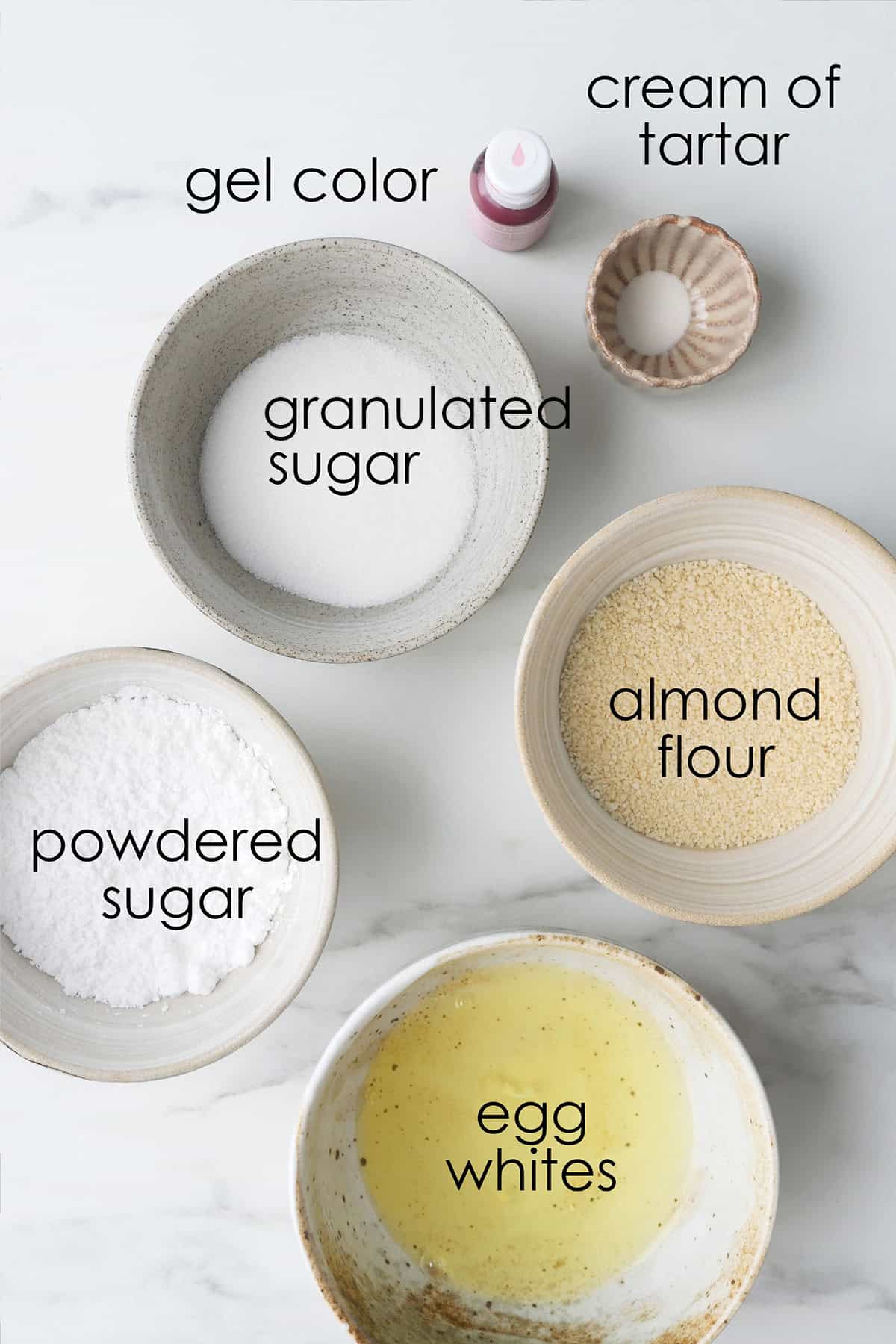Do you really need to rest your macaron shells? Here's what to do to prepare a proper macaron batter and prevent macarons from cracking during baking.

It's almost Easter! I have been seeing a barrage of baked goods in the form of bunnies, Easter eggs and chicks on Instagram. For this new Easter macaron, I wanted to blend the latter two together to make one cohesive design. Because really, what came first? The chicken or the egg? Well, I can tell you that for me, the chicken definitely came first because I piped them first lol.
After I posted these onto Instagram, I received a few questions about techniques and even a request for a tutorial. I will post those questions and answers here to make it easier for anyone not tracking my convos with others. As for the tutorial, I would love to have done one but I didn't get a chance to take any step-by-step photos since my original post theme was to discuss the issue of resting the macaron shell which I did end up making a video for.


What Does Resting the Macaron Shells Mean?
If you've been having bad luck with macarons, you've probably googled many different kinds of advice which seems conflicting at times. One of those is the procedure of "resting" the macaron shells after baking. "Resting" a macaron shell involves letting it air dry for 30 minutes after piping until the surface loses its glossy sheen and you can lightly touch the shell without any trace of the batter transferring to your fingers. Here, watch this video to see me "petting" these chickies:
"Why Should I Rest My Macarons?"
Letting the macaron shell dry out allows the outer surface to harden up so that when it is baked, the air in the batter will escape from the bottom edge (thereby, creating feet) instead of from the top of the macaron which can cause cracks and/or leave you with no feet at all.
No Rest Macaron Recipes
In my best macaron recipe, I do include instructions on resting until there is a skin. There are some macaron recipes out there that call themselves "no-rest" recipes but it should be clarified that there is nothing different that sets them apart from recipes that require resting. It is simply the author telling you not to do so. They are not guaranteeing that your macaron shells won't crack during baking, that part is all up to you.
"So, Do I Need to Rest My Macarons?"
This is definitely a controversial topic in macaron baking. Some bakers swear that they never rest their macarons and others swear by it. From all the readings I have done both online and in print, it appears that most bakers are in favor of doing this. Specifically, in both the Laduree Macarons Recipes Cookbook and Pierre Herme Macaron Cookbook, it instructs to do it in this way:
♥ Laduree: "Set aside uncovered for 10 minutes to allow a crust to form."
♥ Pierre Herme: "Allow the shells to stand at room temperature for about 30 minutes until a skin forms on the surface. The batter should not stick to your fingers."

Even in my macaron class, it was advised to wait for about half an hour until a skin develops. The important wording to pay attention to is "waiting until a skin or crust forms". I don't think it depends so much on the time as it does on the condition of the shell. Sometimes, I can pipe a tray of shells and the ones I piped first can form a crust within the time it took me to finish piping the last one. It really depends on how wet your batter is and on how dry is the environment you are working in.
Now let's get back to the experience of other bakers who do not rest their shells at all and claims that it's not necessary. Yes, it is true, not every batter needs to be rested. If the macaron batter is prepared properly and the environment is ideal, it can be baked right away. Batters that are a bit weak and underdeveloped do benefit from resting. The formation of the skin will prevent shells made with these types of batters from cracking. So resting the macaron shells is extra insurance against cracked shells.
What to Do After Piping
- Rap the tray firmly on the counter several times to release the air bubbles inside the batter which can cause cracks
- Remove visible air bubbles with a toothpick by poking and running the tip around that spot to disperse the batter back into one uniformed batter.
- Wait until a "crust or skin" develops. This is characterized by being able to touch the shell without the batter transferring to your fingers.
- Wait until the surface becomes matte and dull and has lost its glossy sheen.

"My Shells Won't Dry Up"
Sometimes your batter just won't dry up regardless of how long you have been waiting. The two main reasons for that are "Bad/Wet Batter" and "Humid Environment":
Bad/Wet Batter
You should be gaging the health of your batter during the macaronage stage. If it is very easy for the dry and wet ingredients to become homogenous and the batter runs like pancake batter, you may have a case of bad batter on your hands.
There is really no way to fix a bad batter. I would recommend that you bake your shells anyways to gain experience on seeing how a bad batch develops. I recommend baking on parchment paper as it's more forgiving for wetter batters.
Two issues which can prevent a "bad batter" from resting and developing skin are: "wet batter" and "over folding".
To ensure that your macaron batter is not too wet:
- use aged egg whites READ: how to age egg whites for macarons
- beat your meringue very firm until stiff peaks
- do not add any liquids to the mixture, use only gel colour or powder colour
- make meringue in a clean bowl free of oil or traces of yolk or water
To prevent over-folding:
- ensure you are folding with the right techniques to deflate some of the air but not all of it
- use the Figure 8 test to gauge when to stop folding the batter VIDEO: How to Macaronage

Air in the Baking Environment is Too Humid
There's cautionary tales of baking on rainy days and I can only share my experience. I know certain environments can be too humid for the macaron shells to develop a skin. I have heard of baker friends in Hawaii who let their shells dry for hours at a time. I, myself, live in Vancouver, Canada where it rains everyday for months at at time but I do not shy away from baking macarons on the days that it rains.
If you are sure that your techniques are fine and its not a case of bad/wet batter causing your shells to remain wet, you can start on fixing this issue by making changes in your baking environment.
Preparing an optimal environment for baking macarons:
- get a dehumidfier and set it for below 50
- avoid running water for prolonged periods of time in the kitchen
- open all the windows to let moisture escape from your kitchen
- place your shells underneath the range hood fan to further dry them up. (Do not use an external fan to blow directly on the shells. It will make them lopsided.)

"Can My Shells Be Too Dry or "Over-Rested?"
Yes, it can. More is definitely not better. If your shells have already developed a skin and lost its glossy sheen, put them in the oven. Shells that have become too dry may become lopsided when baked or the feet may get stuck to the mat and break off.
Final Verdict
I like to rest my macaron shells and have had great success with them when I rested them. I have also not rested them and a majority of the time, they bake perfectly because the batter was prepared correctly. For the batters that weren't prepared properly and I didn't rest the shells, I have shed a tear or two when they cracked during baking.
FURTHER READING: TOP TIPS ON BAKING SMOOTH AND ROUND MACARONS
Having said all of that, I am a firm believer that for macarons, you should do what works best for you in your kitchen and in your oven. I've given you some of my insights into this issue and I hope it will help you come to your own conclusions. What do you think? Feel free to share your own experience with other fellow bakers below in the comments.
Thanks for visiting!
XOXO,
Mimi
Note: This post was originally published on March 27th, 2015
[pt_view id="a19129e29z"]

Laura says
Please help!! I’ve been making macarons for a few weeks and following all tips correctly. They were turning out great. But the last few times, after I fill them with cream, by the next day the shells are literally dissolving and melting? They turn mushy and liquid oozes out… I can’t find any advice on why. Please help!! Btw I filled them with custard cream…
Mimi says
Hi Laura,
Custard cream is not a great filling for macarons. It contains too much moisture and is generally not sturdy enough for use in macarons. A filling that is similar which you can try is cream anglais blended with a lot more butter at the end. It will give it structure and reduce the ratio of moisture.
XOXO,
Mimi
Naomi says
After I pipe my batter on a baking sheet can I put them in the fridge for the air dry time before baking.
Mimi says
Hi Naomi,
I haven't tried doing that so I can't say from my experience what your results will be after doing so.
If you've tried, please let me know how it goes 🙂
XOXO,
Mimi
ARJAY WINGROVE says
Hi, Mimi: is there a quicker way to age egg whites than leaving them in the fridge 2-4 days prior to using them?
Thanks,
Arjay
Mimi says
Hi Arjay,
I find overnight in the fridge works for me. Some bakers heat up the egg whites in the microwave but from my understanding, this actually ends up causing the proteins to bind together, making a tighter protein bond which is opposite of what we want. If you really don't have time, you can skip it and see if it works for you. Some bakers have the techniques to skip this step from the very beginning.
XOXO,
Mimi
Yeon says
Hi Mimi,
When making character macarons that involve a few colours/sections and thereby requiring piping at different stages, how do we ensure that the macs are not rested for too long in the process of piping? As you said the first (pipes) completed character and the last one will probably be at a different stage of the crust forming during resting? I saw some character macs bakers online say they pipe the shells for 4-5 hours??? Thanks. 🙂
Mimi says
Hi Yeon,
If the batter is kept inside the piping bag, it can usually hold up for at least 1 hour. I like to make multiple colors using this method here, it gives me different colored macaron batters at nearly the same time, reducing the resting time.
XOXO,
Mimi
Aruna says
I have rested my macarons for 2 hours and still no skin formed . Can I put it below a ceiling air conditioner?
Mimi says
Yes you can 🙂
Luciana Misura says
Hello Mimi, thank you for the helpful post. What is the ideal humidity for macarons? For example, today was a dry day here and my kitchen was at 54% humidity. The macarons took way over one hour to dry and not stick to my finger when I touched them. This is usually the case. If I rest them for less than 1 hour they all break in the oven. So I believe I need a dehumidifier, but I wonder at what humidity levels you usually bake. Thanks!
Mimi says
Hi Luciana,
I am from Vancouver and it rains all the time here, it is around 80% humidity. I dont' have experience baking in a humid environment but have heard from other home bakers in Hawaii in Asia that they rest the macaron shells for hours at a time. Sorry, I don't have much experience to share in baking in humid environments. Maybe google might help? 🙂
XOXO, Mimi
Crystal says
Hi Mimi,
I've read your post and I'm still confused on what I did wrong. I've tried 5 times to make macarons but only 1 time was successful.
In the first time, the macraons are cracked and have no feet.
In my second time, the macaron was successful.(I've used fresh eggs)
In my third time, I've used liquid flavoring so the macarons didn't form a skin after 1 hour. Since it took too long for the macarons to form a skin, I decided to bake them anyways. The middle part of the macaron was sticky and it didn't have a feet.
In my fourth time, I did everything correct(The egg whites were at a stiff peak and the batter was at a good consistency)but at that time, someone was cooking in the kitchen. The skin didn't form on the macarons and they didn't form a feet. I googled the problem and I thought that it was because of the humidity.
On my fifth time, the batter was perfect. But since its at night, I needed to cook dinner. So I cooked dinner after I put the macarons into another room to dry. The skin formed on the macarons but when I baked them, there was no feet. Everything else was correct(including the batter, no cracked macarons, no flat macarons, and no sticky macarons).
What did I did wrong?
Mimi says
Hi Crystal,
It sounds like you tried a few times. I'm really proud of your perseverance. It sounds like there is quite a bit of distractions during baking (it happens a lot in my kitchen too), but I don't think any of them is the cause for the lack of feet 🙂 I would definitely skip the liquid food coloring and use gel instead. That is one culprit right there. Make sure your meringue is fully beaten to stiff peaks and use some stabilizers like lemon juice or cream of tartar in the meringue 🙂
XOXO,
Mimi
Evrim kalenderoğlu says
Hello, I live in Turkey and it is really humid here and my batter doesn’t get dry easily . While we are waiting them to get dry , they expand . I tried making macarons two times . At the first time, it was summer and it was so humid. The batter didnt get dry. At last I fell asleep while ı was waiting. At the second time , it was winter and the heater was on. They had a skin at the end of 3 hours but some of them expanded and some of them had crucks on it. I think it was becouse of the humid again. After ı pipe them on the baking paper, I turn on the oven and let it heat. And then I I turn the oven off , open the door and put the tray on the door not in the oven. Do the macarons get dry faster with the heat? Thank you so much🙂
Mimi says
Hi Evrim,
I can't say from experience but I have heard of some bakers drying them this way! So you sound like you might be on the right track. Can you share with us how it turned out?
XOXO,
Mimi
Brandi says
I use a no rest method where I set my oven on as low as it will go and then put my macarons in with the door ajar. I do that for 5-6 min. Then I take them out, close the oven and turn up to 300F and preheat. Once up to temp, I put my tray in the oven and bake. When they are done, I turn the oven off. Crack the oven door open and let them sit there for 5-10 min.
Krishna says
When I make macarons ,it become crack or no feet. What I do maam?
Mimi says
Hi Krishna,
I have a devoted section for cracked shells and fixes on my troubleshooting guide.
XOXO,
Mimi
Emily says
Hello! I live in Georgia, which has very humid summers. I have been letting my macrons rest for 40 minutes+ and they still are kind of wet and shiny. Will resting them longer than an hour be a bad idea? Thank's for the help!
Mimi says
Hi Emily,
I have heard of Hawaiian bakers who let them rest for hours. I haven't baked in such a humid environment (although it does rain almost everyday here for months on end), I can't say from experience but I do believe some climates may require more resting. If your batter is at the right consistency, it should usually bake without needing that much insurance from the resting period. Try waiting longer if they indeed crack with a few test macarons.
XOXO,
Mimi
Fatema says
Hi Mimi,
I have tried your recipe. The first time it was perfect. Seems like a one time wonder. After which I tried them 8 times now. Every time I get the same result. Wrinkled tops. They develop feet, taste amazing but wrinkled tops. What am I doing wrong?
Mimi says
Wrinkled tops usually comes from overwhipping of the egg whites, the protein can no longer hold onto the water and it starts sweating out. There's ways to fix this for next time, take a look at my macaron troubleshooting guide.
XOXO, Mimi
Tessa says
Hi mimi,
I’m literally going crazy over these cookies. Ive been trying to use all your guides to get my macarons fixed. Sadly they progressively get worse...
1. My first attempt I immediately noticed they were runny when I piped them. They developed extremely tiny feet and some cracked. I thought I had to mix less.
2. I mixed less and they developed no feet at all, and they all cracked open almost immediately.
I now ages my egg whited a little under 24 hours and beat the peaks way stiffer and I turned my oven down about 15C
3. I mixed less and they were much easier to pipe, less runny. Again; no feet, all craked.
4. I mixed even less until the figure 8 was JUST possible and again they all cracked and had no feet.
A recurring issue i have is that it takes about 1-2 hours with a direct fan for them to dry and develop a skin...
I don’t know what to try anymore, any advice?
Mimi says
Hi Tessa,
It sounds you have a good process for testing what works for you. Have you looked into the colors you're using? I recommend using Gel colors that won't compromise the integrity of the batter. You might also want to use much less or none at all to see if that's the issue causing your batter to be too "wet". It sounds like the batter might be too wet, a bandaid solution is to let the shells rest much longer creating an extra hard skin that won't crack when baked. ( I also wonder if you're living in a humid environment? some climates do require more resting than others) In the long run, the batter issue should be resolved. Make sure the meringue is stiff enough, until stiff peaks with a firm beak that doesn't bend.
XOXO,
Mimi